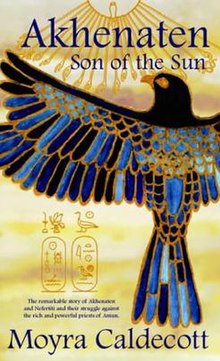
Aten also Aton, Atonu, or Itn was the focus of Atenism, the religious system formally established in ancient Egypt by the late Eighteenth Dynasty pharaoh Akhenaten. Exact dating for the 18th dynasty is contested, though a general date range places the dynasty in the years 1550 to 1292 B.C.E. The worship of Aten and the coinciding rule of Akhenaten are major identifying characteristics of a period within the 18th dynasty referred to as the Amarna Period.

Akhenaten, also spelled Akhenaton or Echnaton, was an ancient Egyptian pharaoh reigning c. 1353–1336 or 1351–1334 BC, the tenth ruler of the Eighteenth Dynasty. Before the fifth year of his reign, he was known as Amenhotep IV.

Mut, also known as Maut and Mout, was a mother goddess worshipped in ancient Egypt. Her name means mother in the ancient Egyptian language. Mut had many different aspects and attributes that changed and evolved greatly over the thousands of years of ancient Egyptian culture.

The Karnak Temple Complex, commonly known as Karnak, comprises a vast mix of temples, pylons, chapels, and other buildings near Luxor, Egypt. Construction at the complex began during the reign of Senusret I in the Middle Kingdom and continued into the Ptolemaic Kingdom, although most of the extant buildings date from the New Kingdom. The area around Karnak was the ancient Egyptian Ipet-isut and the main place of worship of the 18th Dynastic Theban Triad, with the god Amun as its head. It is part of the monumental city of Thebes, and in 1979 it was added to the UNESCO World Heritage List along with the rest of the city. The Karnak complex gives its name to the nearby, and partly surrounded, modern village of El-Karnak, 2.5 kilometres north of Luxor.

The Red House Mystery is a whodunnit by A. A. Milne, published in 1922. It was Milne's only mystery novel.

The New Kingdom, also referred to as the Egyptian Empire, was the ancient Egyptian nation between the 16th century BC and the 11th century BC. This period of ancient Egyptian history covers the Eighteenth, Nineteenth, and Twentieth Dynasties. Through radiocarbon dating, the establishment of the New Kingdom has been placed between 1570 BC and 1544 BC. The New Kingdom followed the Second Intermediate Period and was succeeded by the Third Intermediate Period. It was the most prosperous time for the Egyptian people and marked the peak of Egypt's power.
Moyra Caldecott was a British author of historical fiction, fantasy, science fiction and non-fiction. Her works include Guardians of the Tall Stones and The Egyptian Sequence.
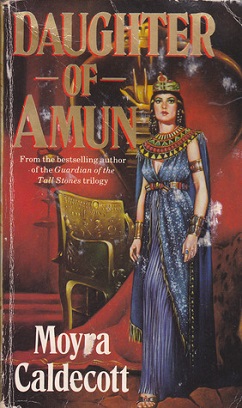
Hatshepsut: Daughter of Amun is a novel written by Moyra Caldecott in 1989. It was first published in Great Britain in 1989 as a paperback by Arrow Books Limited (ISBN 0-09-959850-7).

Atenism, also known as the Aten religion, the Amarna religion, and the Amarna heresy, was a religion in ancient Egypt. It was founded by Akhenaten, a pharaoh who ruled the New Kingdom under the Eighteenth Dynasty. The religion is described as monotheistic or monolatristic, although some Egyptologists argue that it was actually henotheistic. Atenism was centred on the cult of Aten, a god depicted as the disc of the Sun. Aten was originally an aspect of Ra, Egypt's traditional solar deity, though he was later asserted by Akhenaten as being the superior of all deities. In the 14th century BC, Atenism was Egypt's state religion for around 20 years, and Akhenaten met the worship of other gods with persecution; he closed many traditional temples, instead commissioning the construction of Atenist temples, and also suppressed religious traditionalists. However, subsequent pharaohs toppled the movement in the aftermath of Akhenaten's death, thereby restoring Egyptian civilization's traditional polytheistic religion. Large-scale efforts were then undertaken to remove from Egypt and Egyptian records any presence or mention of Akhenaten, Atenist temples, and Atenist assertions of a uniquely supreme god.
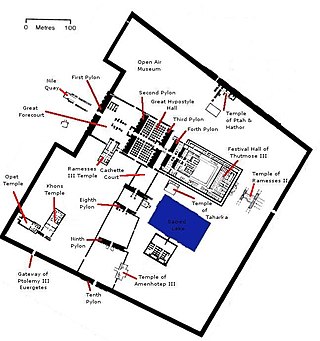
The Precinct of Amun-Re, located near Luxor, Egypt, is one of the four main temple enclosures that make up the immense Karnak Temple Complex. The precinct is by far the largest of these and the only one that is open to the general public. The temple complex is dedicated to the principal god of the Theban Triad, Amun, in the form of Amun-Re.

Gebel el-Silsila or Gebel Silsileh is 65 km (40 mi) north of Aswan in Upper Egypt, where the cliffs on both sides close to the narrowest point along the length of the entire Nile. The location is between Edfu in the north towards Lower Egypt and Kom Ombo in the south towards Upper Egypt. The name Kheny means "The Place of Rowing". It was used as a major quarry site on both sides of the Nile from at least the 18th Dynasty to Greco-Roman times. Silsila is famous for its New Kingdom stelai and cenotaphs.

The Red Chapel of Hatshepsut or the Chapelle rouge was a religious shrine in Ancient Egypt.

Tutankhamun and the Daughter of Ra is a novel written by Moyra Caldecott in 1989. It was first published in 1990 as Daughter of Ra in paperback by Arrow Books Limited (ISBN 0-09-959870-1).
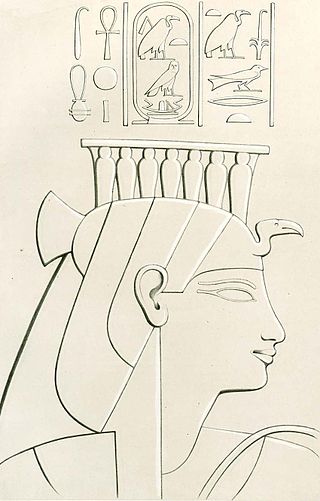
Mutemwiya was a minor wife of the Eighteenth Dynasty pharaoh Thutmose IV, and the mother of Pharaoh Amenhotep III. Mutemwiya's name means "Mut in the divine barque". While unconfirmed, it has been suggested that she acted as regent during the minority of her son Amenhotep III.
Akhenaton, Akhnaton, Akhnaten or Akhenaten may refer to:

The High Priest of Amun or First Prophet of Amun was the highest-ranking priest in the priesthood of the ancient Egyptian god Amun. The first high priests of Amun appear in the New Kingdom of Egypt, at the beginning of the Eighteenth Dynasty.
Amun was a major ancient Egyptian deity who appears as a member of the Hermopolitan Ogdoad. Amun was attested from the Old Kingdom together with his wife Amunet. With the 11th Dynasty, Amun rose to the position of patron deity of Thebes by replacing Montu.
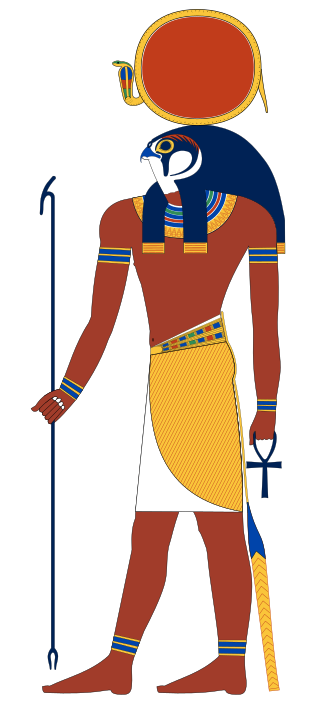
Ra or Re was the ancient Egyptian deity of the Sun. By the Fifth Dynasty, in the 25th and 24th centuries BC, he had become one of the most important gods in ancient Egyptian religion, identified primarily with the noon-day sun. Ra ruled in all parts of the created world: the sky, the Earth, and the underworld. He was believed to have ruled as the first pharaoh of Ancient Egypt. He was the god of the sun, order, kings and the sky.

The Eighteenth Dynasty of Egypt is classified as the first dynasty of the New Kingdom of Egypt, the era in which ancient Egypt achieved the peak of its power. The Eighteenth Dynasty spanned the period from 1550/1549 to 1292 BC. This dynasty is also known as the Thutmosid Dynasty for the four pharaohs named Thutmose.
A Son of the Sun may refer to:
